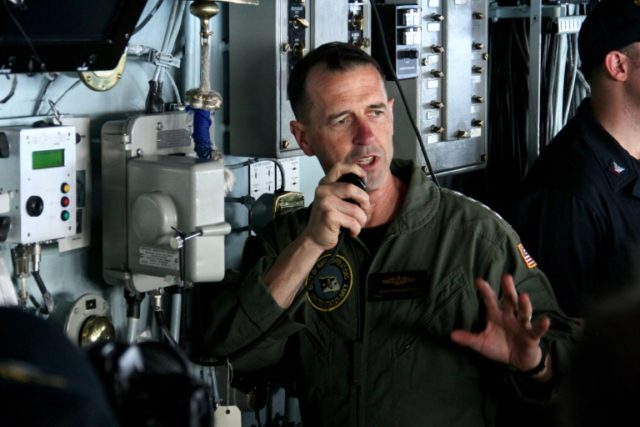The U.S. military’s chief of naval operations traveled to Beijing on Sunday for a four-day visit focused on “results-oriented, risk-reduction” talks between the Chinese and American armed forces amid the growing geopolitical and military rivalry between two nations, the United States Navy revealed in a statement Monday.
Referring to Monday’s meeting in Beijing between U.S. Adm. John Richardson, the chief of American naval operations (CNO), and his Chinese counterpart, Vice Adm. Shen Jinlong, the commander of the People’s Liberation Army (Navy), the United States Navy said, “The two heads of navy discussed professional interactions at sea, specifically addressing risk reduction and adherence to rules of behavior.”
Adm. Richardson declared:
There is no substitute for these types of face-to-face meetings. Given the responsibilities that our navies have in the larger nation to nation relationship, we must work together. These meetings between senior leaders allow us to speak candidly about areas where we agree and about how to manage risk while we resolve our differences. … Our vision of a free and open Indo-Pacific excludes no nation, and we recognize that while our two nations may not always agree, it serves both our people’s interests to engage where we can.
Richardson is expected to visit Beijing as well as the eastern city of Nanjing and meet other members of China’s Central Military Commission, the U.S. Navy statement revealed.
China’s state-run Global Times welcomed Richardson’s trip as a chance for dialogue amid Washington-Beijing tensions, noting:
Richardson’s visit comes at a time when China-US trade talks are intensifying, and overall bilateral tensions have not yet eased. Increasing concerns about future military friction between the two powers have emerged. Particularly at sea, there is a high risk of unexpected military disputes. … If dialogue fails to help Washington understand this, Beijing needs to take practical action to help the US correct its vision. Richardson’s visit to China is an important opportunity for China and the US to improve mutual understanding and reduce misjudgments. It is hoped the two sides can better understand each other and reach a consensus on how to avoid conflicts which neither side wishes.
The Global Times suggested that flexing military muscle “is the most important way to win more U.S. respect for China’s sovereignty.”
“China must have the ability to make rivals pay unbearable costs when the country is forced into offshore combat and also the unquestionable capability of strategic nuclear counterattack. This is the basis for the US to respect China’s core interests in the latter’s offshore waters, and China should not ever vacillate,” it added.
The latest Global Firepower (GFP) index, which ranks 133 countries annually, deemed the United States armed forces the most powerful military in the world trailed by Russia, China, and India respectively.
“In terms of overall strength, the People’s Liberation Army is no match for the US Army and such a reality will last a long time,” the Global Times conceded. “But China must dare to show its volition to safeguard its core interests while knowing when to exercise patience.”
Last February, the U.S. Pacific Command (USPACOM) cautioned that China’s “impressive military buildup” in the South China Sea might soon enable the People’s Liberation Army (PLA) to challenge America’s military dominance in the Indo-Pacific region “across almost all domains.”
Richardson’s visit comes at a time when China and the United States are engaged in a multi-faceted dispute over trade, technology, and territorial disputes in the South China Sea — considered one of the world’s most valuable waterways.
“Beijing’s increasingly aggressive stance within it has stoked fears of a major power clash between China and the US,” the South China Morning Post (SCMP) noted, referring to the South China Sea.
Days before Richardson arrived in Beijing, Vietnam reportedly used a United States freedom of navigation exercise involving the guided-missile destroyer USS McCampbell to stake its claim in the South China Sea, risking the ire of Beijing.
Vietnam is using a balancing act in its relations with Beijing and Washington, the Morning Post reported Monday, adding: “Hanoi used the latest row over a US freedom of navigation operation in the disputed waterway to not only show its support for its Western ally but also reaffirm its territorial claims there.”
Marking one of the latest U.S. patrols in the South China Sea that prompted condemnation from Beijing, the USS McCampbell on Monday sailed within 12 nautical miles of the disputed Paracel chain claimed by Vietnam, China, and Taiwan.
The U.S. Pacific Fleet described the move — blasted by China — as an operation to “challenge excessive maritime claims”.
Vietnam has emerged as the top U.S. supporters in Southeast Asia, the Morning Post pointed out, citing a recent study by the ISEAS-Yusof Ishak Institute in Singapore found.

COMMENTS
Please let us know if you're having issues with commenting.